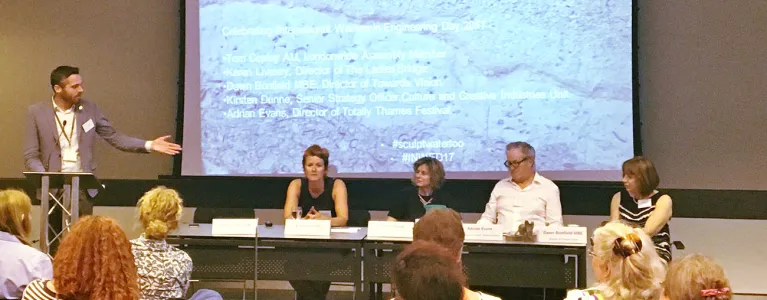
It was one of London’s best kept secrets, but this week the legacy – and the future - of the so-called Ladies’ Bridge was discussed at City Hall. During World War II hundreds of women were involved in the rebuilding of Waterloo Bridge, but their contribution was not publicly recognised for over half a century. Now, the campaigners who secured that recognition, are taking the story into London’s schools by revitalising a decades old competition. London Assembly Member Tom Copley AM, who hosted the event ahead of International Women in Engineering Day, said he hoped the event would “encourage a new generation of female engineers”.
During the Second World War women played a key role in the construction of Waterloo Bridge. While official history had written this story out – indeed, the former leader of London County Council explicitly thanked “men” for their contribution - Thames riverboat pilots had kept the story alive by telling stories of the Ladies’ Bridge. In 2005, film-maker Karen Livesey made a documentary which explored the story of the bridge builders and 25,000 other female construction workers. Following a campaign to try and track down evidence of the women who worked on the Bridge, photographs were discovered proving the women’s contribution. As part of Totally Thames festival in 2016, the images were projected on the Southbank.
The fact that many Londoners remain unaware of the history of Waterloo Bridge, and that just 9% of engineering workforce in the UK is female which is the lowest is Europe, has led to the Ladies’ Bridge organisation to revisit a project first launched in 1947. London County Council challenged prominent artists to complete the bridge by providing sculptural designs for its four plinths. Despite designs being produced by Barbara Hepworth, Charles Wheeler, Frank Dobson and Eric Kennington, none were chosen, and the plinths remain empty to this day.
Project Sculpture will be open to schools across the capital and will culminate in an exhibition during the Thames Festival in 2018. Although no agreement has been reached regarding the current empty plinths, it is hoped something more permanent to commemorate women’s contribution to Waterloo Bridge (and the work of women during the two World Wars in general) will be commissioned.
Karen Livesey, Director of The Ladies’ Bridge said:
‘’I am delighted that this project will stimulate more focus on the work of the women construction workers who built the bridge during the Second World War, and that their stories will act as inspiration to other women to enter the world of construction and engineering, where we are facing a major skills shortage’’.
Dawn Bonfield MBE, founder of International Women in Engineering Day, and immediate past President and former Chief Executive of the Women's Engineering Society (WES), said:
“This project offers a fantastic opportunity to inspire the next generation of students to explore ways of combining art, sculpture, engineering and manufacture to produce something that tells the story of the bridge, drawing inspiration from its history, its surroundings and the future opportunities that exist in these converging disciplines”.
Labour Londonwide Assembly Member, Tom Copley AM said:
“As it was the London County Council which first envisaged the idea of a sculpture on the plinths at Waterloo Bridge, I was delighted to host this event at the home of its successor at City Hall. I hope that we can both commemorate the contribution these women made to London, and encourage a new generation of female engineers‘’.
Notes to editors
- More information about the history of Waterloo Bridge and the campaign to recognise women’s contribution to its construction can be found here;
- The statistics on women in engineering can be found here http://www.wes.org.uk/content/useful-statistics
- International Women in Engineering Day (#INWED17) takes place on 23 June annually and was set up by the Women’s Engineering Society in 2014 to celebrate its 95th anniversary;
- The Light up the Ladies Bridge project took place in September 2016 as part of the annual Totally Thames Festival;
- The 1947 Waterloo Bridge Plinth Design competition details can be found here http://www.tate.org.uk/art/artworks/hepworth-model-for-project-for-waterloo-bridge-the-river-t07941;
- Two maquettes designed by Barbara Hepworth are held at the Tate Gallery in Cornwall and the National Galleries Scotland;
- Karen Livesey and Dawn Bonfield MBE are the curators of Project Sculpture for Waterloo Bridge;
- Attached is a picture of Tom Copley AM speaking at the event at City Hall.
- Tom Copley is a Labour Londonwide Assembly Member.